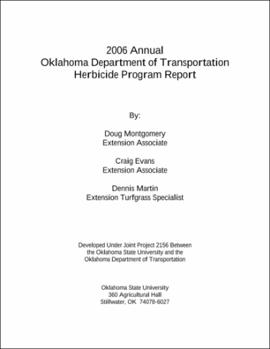| dc.description.abstract | The purpose of this annual report was to document the successes, failures and challenges of ODOT chemical weed control program in 2006. As each field division makes herbicide application decisions independent of other divisions, we attempted to minimize comparisons among divisions. However, it can be interesting and useful to examine trends in herbicide programs among/between divisions. We attempted to document the progress of each field division on its own merit, considering their different attitudes and unique management goals. When appropriate, recommendations and comments were made to assist divisions in solving issues that became apparent after reviewing this year's herbicide use surveys (Appendix A) and divisional meetings. It was our intent that the comments and criticisms included in this report would be of benefit to each field division's herbicide program. We are aware that each field division, in the development of its herbicide program, may have considerations unknown to Oklahoma State University Roadside Vegetation Management Program personnel. If there is disagreement by any division personnel as to our comments or recommendations, we ask that we have the opportunity to clarify recommendations. The greatest challenge this year was the statewide drought that persisted from Sept. � through Sept. �. Oklahoma is a state that is well aware of drought issues, but this past year the severity and duration was unprecedented. Many state records have been broken with respect to the drought of 2006. From this report/survey it has been documented that ODOT treatment acreages were down significantly from the past and that weed control results for many applications were poor. These results were a both a direct and indirect effect of the drought conditions. Results should be viewed as ODOT personnel trying to do their best in a very difficult season rather than there being a poor effort from ODOT personnel. ODOT should be able to continue its historically sound herbicide programs once more 搉ormal� climatic conditions return. An attempt will be made in Section 10 of this report to explain the plant responses to drought conditions and the drought抯 effect on herbicide efficacy. Such a discussion should help explain some of the decisions made this past year, weed control results and problems experienced by many. In the body of this report most references to herbicides will be made by using their common name instead of their brand name. An example would be a reference to 慻lyphosate�, the active ingredient, instead of 慠oundup Pro Concentrate畳, 慔oncho Plus畳, or 慚irage畳, which are the brand or registered trade names. This is an attempt to simplify the text of this report. When referenced common names are unfamiliar to the reader you may refer to Table 11 for the corresponding brand name. Each Field Division抯 Summary Table (Tables 1-8) will reference common name followed by brand names in parentheses. Finally, we would like to thank the divisions for their participation in this year's survey. Without the survey data and meetings held at each field division, this report would not reflect the entire ODOT herbicide program effort. We encourage each ODOT maintenance facility to fill out the annual herbicide program survey as accurately and completely as possible so that these reports can accurately reflect ODOT抯 weed control efforts. We encourage suggestions as to how this report can be made more informative and useful and we always welcome input from all levels within ODOT. | |
